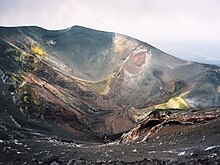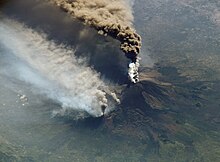Mount Etna: Difference between revisions
| [pending revision] | [pending revision] |
Undid revision 131283717 by 207.190.244.50 (talk) |
No edit summary |
||
| Line 12: | Line 12: | ||
| Age=500,000 years |
| Age=500,000 years |
||
| Last eruption=[[May]] [[2007]] |
| Last eruption=[[May]] [[2007]] |
||
| first to clime=Will Dow |
|||
| First ascent= |
|||
| Easiest route=rock climb |
| Easiest route=rock climb |
||
}} |
}} |
||
Revision as of 13:21, 16 May 2007
| Mount Etna | |
|---|---|
 | |
| Highest point | |
| Elevation | 3,357 m (11,014 ft) |
| Prominence | 3,357 m (11,014 ft) |
| Isolation | 998.79 km (620.62 mi) |
Mount Etna (also known as Mongibeddu in Sicilian and Mongibello in Italian, a combination of Latin mont- and Arabic jebel, both meaning mountain) is an active volcano on the east coast of Sicily, close to Messina and Catania. It is the largest active volcano in Europe, currently standing about 3,326 m (10,910 ft) high, though it should be noted that this varies with summit eruptions; the mountain is 21.6 m (71 ft) lower now than it was in 1865. It is the highest mountain in Italy south of the Alps. Etna covers an area of 1190 km² (460 square miles) with a basal circumference of 140 km. This makes it by far the largest of the three active volcanoes in Italy, being nearly three times the height of the next largest, Mount Vesuvius.
Mount Etna is one of the most active volcanoes in the world and is in an almost constant state of eruption. Although it can occasionally be very destructive, it is not generally regarded as being particularly dangerous,[citation needed] and thousands of people live on its slopes and in the surrounding areas. The fertile volcanic soils support extensive agriculture, with vineyards and orchards spread across the lower slopes of the mountain and the broad Plain of Catania to the south. Due to its history of recent activity and nearby population, Mount Etna has been designated a Decade Volcano by the United Nations.
Name and legends

Etna was known in Roman times as Aetna, a name thought to have derived either from the Greek word aitho ("to violently burn") or the Phoenician word attano. The Arabs called the mountain Gibel Utlamat ("the mountain of fire"); this name was later corrupted into Mons Gibel (literally 'Mountain Mountain') and subsequently Etna's current local name Mongibeddu. The Greek word "Etna" means "I burn".
The mountain's regular and often dramatic eruptions made it a major subject of interest for Classical mythologists and their later successors, who sought to explain its behaviour in terms of the various gods and giants of Roman and Greek legend. Aeolus, the king of the winds, was said to have imprisoned the winds in caves below Etna. The giant Typhon was confined under Etna, according to the poet Aeschylus, and was the cause of the mountain's eruptions. Another giant, Enceladus, rebelled against the gods, was killed and was buried under Etna. Vulcan, the god of fire and the forge, was said to have had his forge under Etna and drove the fire-demon Adranus out from the mountain, while the Cyclops maintained a smithy there where they fashioned lightning bolts for Zeus to use as a weapon. The Greek underworld, Tartarus, was supposed to be situated beneath Etna.
Empedocles, a major pre-Socratic philosopher and Greek statesman of the 5th century BC, was said to have met his death in the volcano's crater. Etna supposedly erupted in sympathy with the martyrdom of Saint Agatha in 251 AD, prompting Christians thereafter to invoke her name against fire and lightning.
Geological history

Volcanic activity at Etna began about half a million years ago, with eruptions occurring beneath the sea off the then coastline of Sicily. 300,000 years ago, volcanism began occurring to the southwest of the present-day summit, before activity moved towards the present centre 170,000 years ago. Eruptions at this time built up the first major volcanic edifice, forming a strato-volcano in alternating explosive and effusive eruptions. The growth of the mountain was occasionally interrupted by major eruptions leading to the collapse of the summit to form calderas.
From about 35,000 to 15,000 years ago, Etna experienced some highly explosive eruptions, generating large pyroclastic flows which left extensive ignimbrite deposits. Ash from these eruptions has been found as far away as Rome, 800 km to the north.
Thousands of years ago, the eastern flank of the mountain experienced a catastrophic collapse, generating an enormous landslide in an event similar to that seen at Mount St. Helens in 1980. The landslide left a large depression in the side of the volcano, known as 'Valle del Bove' (Valley of the Ox). Research published in 2006 suggests that this occurred around 6000 BC, and caused a huge tsunami which left its mark in several places in the eastern Mediterranean. It may have been the reason that the settlement of Atlit Yam (Israel), now below sea level, was suddenly abandoned around that time. (Pareschi et al., Geophys. Res. Lett., 33, doi:10.1029/2006GL027790)
The steep walls of the Valley have suffered subsequent collapse on numerous occasions. The strata exposed in the valley walls provide an important and easily accessible record of Etna's eruptive history.
The most recent collapse event at the summit of Etna is thought to have occurred about 2,000 years ago, forming what is known as the Piano Caldera. This caldera has been almost entirely filled by subsequent lava eruptions, but is still visible as a distinct break in the slope of the mountain near the base of the present-day summit cone.
Historical eruptions
The first known record of an eruption at Etna is that of Diodore of Sicily.
The Roman poet Virgil gave what was probably a first-hand description of an eruption in the Aeneid: Template:MultiCol
Portus ab accessu ventorum immotus et ingens
ipse; sed horrificis iuxta tonat Aetna ruinis;
interdumque atram prorumpit ad aethera nubem,
turbine fumantem piceo et candente favilla,
attollitque globos flammarum et sidera lambit;
interdum scopulos avolsaque viscera montis
erigit eructans, liquefactaque saxa sub auras
cum gemitu glomerat, fundoque exaestuat imo.(3.39)
| class="col-break " |
A spreading bay is there, impregnable
To all invading storms; and Aetna's throat
With roar of frightful ruin thunders nigh.
Now to the realm of light it lifts a cloud
Of pitch-black, whirling smoke, and fiery dust,
Shooting out globes of flame, with monster tongues
That lick the stars; now huge crags of itself,
Out of the bowels of the mountain torn,
Its maw disgorges, while the molten rock
Rolls screaming skyward; from the nether deep
The fathomless abyss makes ebb and flow.
(edition of Theodore C. Williams, ca. 1908 [lines 569 - 579]) Template:EndMultiCol
In 396 BC, an eruption of Etna is said to have thwarted the Carthaginians in their attempt to advance on Syracuse during the First Sicilian War.
1669 eruption
Over the last 2000 years, activity at Etna has been generally effusive, with occasional explosive eruptions from the summit. Its most destructive eruption during this time occurred in March 1669, when an estimated 830,000,000 m³ of lava was ejected. The eruption was preceded by two months of increasingly powerful earthquakes centred on the southern slopes of the mountain, which eventually encouraged most villagers there to abandon their homes. On 11 March, a 9 km-long fissure opened up on the southern flank of the mountain, stretching from an elevation of 2800 m down to 1200 m. Activity steadily migrated downslope, and the largest vent eventually opened near the town of Nicolosi. The cinder cone built up at the erupting vent became known as Monti Rossi (red hills), and is still a prominent landmark today.
Nicolosi was quickly destroyed by lava flows, and two nearby small villages were also destroyed during the eruption's first day. The eruption was extremely voluminous, and a further four villages were destroyed in the following three days as the lava flowed south. In late March two larger towns were destroyed, and the lava reached the outskirts of Catania in early April.
At first, lava piled up against the city walls, which were strong enough to withstand the pressure of the flow. However, while the city was temporarily protected, lava flowed into its harbour and filled it in. On 30 April, lava flowed over the top of the city walls, which then gave way. Catanians built walls across major roads to halt the flow of the lava, which were fairly effective but did not prevent the destruction of the western side of the city.
During the eruption, Catania residents also attempted to divert the flows much further upstream. According to a possibly apocryphal tale, their efforts were met with armed resistance from the citizens of a town which would have been threatened by the diverted flow [1]. Whether this event really occurred or not, a law was subsequently passed to forbid the artificial diversion of lava flows. This law was only repealed in 1983.
Recent eruptions

Another very large lava flow from an eruption in 1928 led to the first destruction of a town since the 1669 eruption. In this case, the town of Mascali was obliterated in just two days, with the lava destroying every building. The event was used by Mussolini's Fascist regime for propaganda purposes, with the evacuation, aid and rebuilding operations being presented as models of fascist planning. Mascali was rebuilt on a new site, and its church contains the Italian fascist symbol of the torch, placed above the statue of Christ.
Other major twentieth century eruptions occurred in 1949, 1971, 1983 and 1992, as well as the twenty-first century 2001 eruption. In 1971, it buried the Etna Observatory (built in the late 19th century) under lava. The 1992 eruption saw the town of Zafferana threatened by a lava flow, but successful diversion efforts saved the town with the loss of only one building a few hundred metres outside it.
In 2002-2003, the biggest series of eruptions for many years threw up a huge column of ash that could easily be seen from space and fell as far away as Libya, on the far side of the Mediterranean Sea. Seismic activity in this eruption caused the eastern flanks of the volcano to slip by up to two metres, and many houses on the flanks of the volcano experienced structural damage. The eruption also completely destroyed the Rifugio Sapienza, on the southern flank of the volcano. Footage from the eruptions was recorded by Lucasfilm and integrated into the landscape of the planet Mustafar in the 2005 film Star Wars Episode III: Revenge of the Sith. The Rifugio was the site of a cable car station which had previously been destroyed in the 1983 eruption; both have now been rebuilt. The most recent eruptions occurred in April 2007, with three recorded so far[citation needed], the latest being on 30th April 2007.
See also
References
- Template:VNUM
- Chester, D. K. (1985). Mount Etna: The Anatomy of a Volcano. Stanford University Press. pp. 412 pp. ISBN 0-8047-1308-1.
{{cite book}}: Unknown parameter|coauthors=ignored (|author=suggested) (help)
- ^ a b The elevation varies with volcanic activity. It is frequently given as 3,350 m, but many sources that support this concede that it is approximate. The elevation and coordinates given here, which are consistent with SRTM data, are from a 2005 GPS survey.
External links
- Mt Etna Photos
- Mount Etna Live Webcam
- Italy's Volcanoes: The Cradle of Volcanology, with detailed information of Italy's volcanoes, including Etna
- Stromboli Online, with info on Etna as well as excellent photo galleries and video clips of Etna's past eruptions including those of the 1990s and the 2000s
- Images of the October 2006 eruption by Fred Kamphues
